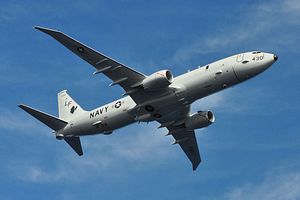As my colleague Franz-Stefan Gady discussed on Friday, a Poseidon P-8A maritime surveillance aircraft belonging to the U.S. Navy was targeted with what U.S. officials described as a “military grade” laser. The laser was directed against the U.S. aircraft by a Chinese People’s Liberation Army Navy (PLAN) warship with the incident taking place in Pacific Ocean waters near Guam, outside of the United States’ exclusive economic zone. The specific location of the incident was some 610 kilometers west of Guam, in waters in the Philippine Sea.
The U.S. Navy has already addressed the irresponsible nature of the alleged conduct by the Chinese PLAN crew. “The P-8A was operating in international airspace in accordance with international rules and regulations,” the U.S. Navy said in a statement last Thursday. The Navy pointed out that the conduct was inconsistent with China’s agreement to the 2014 Code for Unplanned Encounters at Sea, or CUES, which was agreed at that year’s Western Pacific Naval Symposium.
“CUES specifically addresses the use of lasers that could cause harm to personnel or damage to equipment,” said the Navy. “Weapons-grade lasers could potentially cause serious harm to aircrew and mariners, as well as ship and aircraft systems,” it added in a statement.
In the broader scheme of Chinese military provocations against U.S. forces, however, last week’s incident takes on particular significance. The incident is neither novel in kind or at the higher end of intensity. Indeed, there have been prior incidents of U.S. military air crews being targeted by lasers and, in 2018, a Chinese warship nearly collided with a U.S. warship conducting a freedom of navigation operation in the South China Sea.
What is notable about last week’s incident is the fact that it took place in airspace nowhere near Chinese claims or a Chinese overseas military base. In May 2018, the U.S. Federal Aviation Administration reproduced a Notice to Airmen (NOTAM) originally issued by the U.S. military warning of “multiple lazing events involving a high power laser” in airspace near China’s new military base in Djibouti. The NOTAM warned aviators to “use extreme caution when transiting near this area” and further advised pilots that “if a laser is seen in or near Djibouti” to notify air traffic controllers in the area.
The novelty in last week’s incident is that these types of tactics are apparently now spreading to the Western Pacific/Philippine Sea, suggesting a more risk-acceptant PLAN that may be willing to actively impede navigational and overflight freedoms of U.S. military assets far from Chinese shores and Chinese overseas bases. The precedent is concerning, especially as it comes at a time of intensifying competition between the United States and China on a global scale.

































